A Costly Passion
 www.ukm.my/mbz Final Update, 2007 Apr 19, (if they were not deleted) www.ukm.my/mbz Final Update, 2007 Apr 19, (if they were not deleted)
|
|
Dated: 1428 J'Awal 23; 2007 Jun 19 Tue
One of the object of my passion during my tenure in UKM was what is today ICT, with the mother of all the harewares: computer. It began in 1972/1973, after the age of slide rule, which succeded the log book. It was not even a calculater (except the adding machine for the shopkeepers), and many more years to go before the PC.
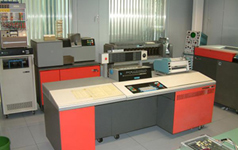  In 1972 (I was in second year undergraduate) UKM bought an IBM 1130 mainframe. Apart from used by the treasury, it was offered for science student to devour its academics, initially as an optional paper in the Math Department under Drs M Bunyamin - the teacher that first inseminate my passion on this piece of fast evolved machine. It was also rumoured at that time that this subject was going to replace the social science subject that science students had to take. I grabbed the first chance I get. Since then I used it a lot, even in calculating the practical results (iteration). Its operation required a span of FORTRAN 4 understanding. And the input was via card reader. Every single data and instruction; a card for each line. With a firm fundation of computing, I graduated a chemist in 1974 Apr, and went for the postgraduate course in the same year Sep, in England. That was the only formal lessons I got for the computing from Drs M Bunyamin. The rest of the knowledges were acquired by myself, driven by only one force: passion. In 1972 (I was in second year undergraduate) UKM bought an IBM 1130 mainframe. Apart from used by the treasury, it was offered for science student to devour its academics, initially as an optional paper in the Math Department under Drs M Bunyamin - the teacher that first inseminate my passion on this piece of fast evolved machine. It was also rumoured at that time that this subject was going to replace the social science subject that science students had to take. I grabbed the first chance I get. Since then I used it a lot, even in calculating the practical results (iteration). Its operation required a span of FORTRAN 4 understanding. And the input was via card reader. Every single data and instruction; a card for each line. With a firm fundation of computing, I graduated a chemist in 1974 Apr, and went for the postgraduate course in the same year Sep, in England. That was the only formal lessons I got for the computing from Drs M Bunyamin. The rest of the knowledges were acquired by myself, driven by only one force: passion. |
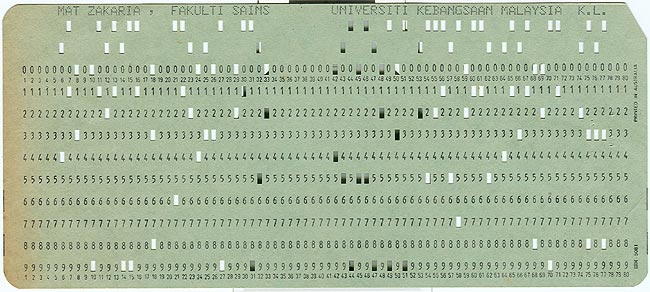 |
| When I return for duty in 1976, Chem Dept had already perchased a PDP-11, which was considered a minicomputer. It took Dr Noramly, the Dean, and former head of Chem Dept who was a very pragmatic person to make this perchase possible. PDP input on a keyboard terminal was very convenient. And the storage was on a tape. I once attended a session of how to use it. But it appeared like it was for a serious computation work, like for the physicist. My requirement was just a "part-time" computing. So I did not quite acquired the skill of using PDP. Dr Zainul Abidin Sharif of Physics Dept was then a very expert PDP user. |
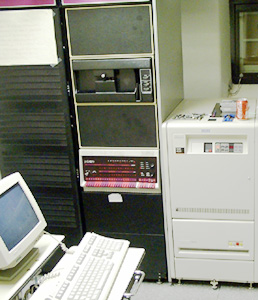 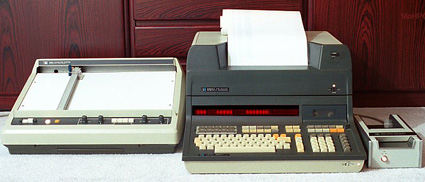 Chem Dept had also purchased several pertable HP computation machines. These were very close to microcomputers. Its input was by a keyboard console using BASIC as its language which was very easy to learn, and storage is on a cassette tape (the same one that stores the songs for ordinary person). The plotter was alluring. My juniors had the opportunity to use them under Dr Gary Kuehnlenz, a theoretical chemist. I used it a lot later, especially the plotter, in mid eighties together with the primitive PC which had made their appearance. The plotter could be programmed to draw on a paper using a thick black ink suitable for direct paste onto CRC (in the mechanics of printing in the eighties). And it was my sole pleasure to use it, because by then no one had any skill to use it, and did not bother to learn it. The old guards had become 'illiterate', while the young turks began with PC. |
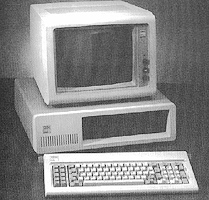  |
The first PC the Chem Dept acquired was around 1985. It was an IBM clone, and was known in the Dept as IBM-F. It was DOS operated on 5.5" FDD. The word processor was Wordstar, and a data processor dBASE. The output was on the dot-matrix. The advent of PC brought some catarophic effect. The academia had competitors: the typist in office whose product previously via typewriter was invariably the same: the letter.
I could not resist to lay my fingers on the keyboard. The sense of trouble if I lay my fingers on it was not strong enough, because of its enormous advantage I saw from it. I could sort my student grade using the dBASE very fast. At that time I was teaching the first year fundamental physical chemistry for almost every science based faculties. At one point it was ca. 650 students, including 150 stempeding for a place in the second year medical. And I had in mind many manuscripts waiting to be typed for submission. The latter was time consuming, and had squeezed much of the PC hours into my favour. It was distasteful to the eye of the then head of department (who incidentally eyeing to use it as well for his promotion).
The dot-matrix output was not so acceptable to the publishers. It could be enhanced by using an IBM golf-ball. But at the expence of a lot of carbon ribbons which the clerk was not very happy. I sorted it out by asking the typist to favour me with the used cartridge of the ribbon. So that I could rewind it and rerun for the second time. It was satisfactory with me. And thanks the clerk and the typist who defended me every time an eye did not look straight at me. Eventually, I got it one manuscript ready for submission. It was published in 1988 by Dewan Bahasa dan Pustaka: Prinsip Kimia Polimer. When the manuscript was submitted, it was the first time DBP received in soft copy from an author, in 50 pcs of 1.2 MB 5.5" floppy. The drawings and the illustrations (in HP plotter output) were still in hard copies. An accompanying harcopy nevertheless was still required.
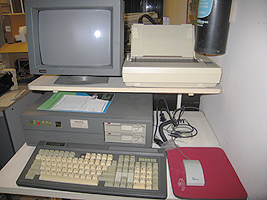 In 1988 the chitin group recieved a handsome grant that the leader Dr Arisol pushed to acquire a set of PC, the Accent 2000. It was placed in the lab, but I had access as free as others. So practically I had a full PC at my disposal (still dot-matrix though). By then KBSM arrived, so I had no resistance to trottle full speed. All my partners rely on me and the Accent 2000 for the shuttle manuscript throughout the preparation. In 1988 the chitin group recieved a handsome grant that the leader Dr Arisol pushed to acquire a set of PC, the Accent 2000. It was placed in the lab, but I had access as free as others. So practically I had a full PC at my disposal (still dot-matrix though). By then KBSM arrived, so I had no resistance to trottle full speed. All my partners rely on me and the Accent 2000 for the shuttle manuscript throughout the preparation.
By this time Windows made its appearence. Some applications were already in windows. One of them was a DTP by the name Ventura. It appealed because of its ability to produce what was called CRC. When my sabbatical ended 1989 Dec 31, I produced the report entirely in Ventura, including the cover design and the simple drawings. The complex drawing was pgotocopied and pasted (by traditional method). Then into a CRC. It was published (1992): Rentasan Kimia Fizik, FOC by Pustaka Aman Press which by then had published two of my KBSM textbooks, and the third one was in the order. |
By this time a PC had had reduced its cost to a reachable level. The IBM-F was acquired at ca. 15K for the quotation "original IBM motherboard" instead of "original IBM computer". The former forms then was as low as 3K depending on how ignorant one is with the ICT terms. It was quite amazing because my passion had not yet reached it. And I could not reach it unless I have one to reach. And I could could it only if it is fully mine.
Translation works from DBP was very much in the process at the time. This has persuaded me a lot to subject my passion on PC. For sure I could not dwell very much on the office equipment. Many colleagues, and the head, had acted in their distasteful mood since many years ago from the IBM-F experience. Translation could be very much speeded up if it could be keyed-in directly. I was on the verge of embarking on two sets. One in my office, and the other one at home, so that I could harbour on both at any appearence of free time.
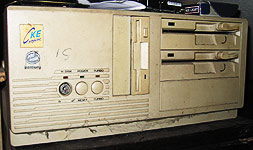 So, I went for it. The first one, 1992 Oct 30 in Jln Reko Kajang. A 286 AT 10/20 MHz; 1mb RAM, 40mb HDD, 256k VGA. With monitor, 2850 RM. CDD was not yet very much a fashion, unless for movie (which require MPEG accessories to support it). It was Windows OS, and wordprocessesor Wordstar was the windows version. And a kind of printer was also something that I eventually had to deal with. To complement what had in mind for the translation, I embarked on another one in Subang Parade, the next day, 1992 Oct 31. But a lower version of used Datamini (genuine clone). A 8088, or better known as XT, 20mb HDD, all for 1800 rm. This one was not good at all. It was a waste of money. And implicitly taught me the first lesson to my passion of ICT: may be I should jump into the hardware myself. My first observation was that: the piece was assembled from samller pieces. Were the pieces available to the public? I was probing into the question of how hard was it the assembly part of the hardware. And then getting the software to make the machine run. So, I went for it. The first one, 1992 Oct 30 in Jln Reko Kajang. A 286 AT 10/20 MHz; 1mb RAM, 40mb HDD, 256k VGA. With monitor, 2850 RM. CDD was not yet very much a fashion, unless for movie (which require MPEG accessories to support it). It was Windows OS, and wordprocessesor Wordstar was the windows version. And a kind of printer was also something that I eventually had to deal with. To complement what had in mind for the translation, I embarked on another one in Subang Parade, the next day, 1992 Oct 31. But a lower version of used Datamini (genuine clone). A 8088, or better known as XT, 20mb HDD, all for 1800 rm. This one was not good at all. It was a waste of money. And implicitly taught me the first lesson to my passion of ICT: may be I should jump into the hardware myself. My first observation was that: the piece was assembled from samller pieces. Were the pieces available to the public? I was probing into the question of how hard was it the assembly part of the hardware. And then getting the software to make the machine run.
|
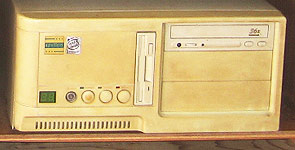 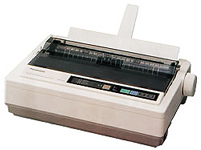 With the XT was a mistake, the demand for another one resurfaced. By now, the printer was in need as well, if I did not want to get stared at again. So, 1993 Apr 29, I ordered another piece set, complete with printer, Idwal's Epsilon 386, which was promoted as running by a new IT tech called MMX. 33 MHz processor, 4mb RAM, 120mb HDD, one 5.5" FDD 1.2mb, one 3.5" FDD 1.4mb (which had shown a much better holding capacity). And a Panasonic KXP1121 dot-matrix. All together 5K flat. With the XT was a mistake, the demand for another one resurfaced. By now, the printer was in need as well, if I did not want to get stared at again. So, 1993 Apr 29, I ordered another piece set, complete with printer, Idwal's Epsilon 386, which was promoted as running by a new IT tech called MMX. 33 MHz processor, 4mb RAM, 120mb HDD, one 5.5" FDD 1.2mb, one 3.5" FDD 1.4mb (which had shown a much better holding capacity). And a Panasonic KXP1121 dot-matrix. All together 5K flat.
One day, while still in the warranty, I took the epsilon to the supplier for one of the FDD did read properly. On inquiry a few days later, I overheard in the phone call, that the proprieter said to her technician that I was a dumb computer user, for the faulty was just the dirty FDD. I took back my piece, and that was the time I visited the supplier. But the rude remark behind my back was a lesson number two to my passion. I did not wait for lesson number three. Plus the very fast development in the IT industries, I began my own quest. First upgrading the RAM from 4mb to 16mb (which cost me 700 RM in Imbi Plaza), and for a moment, my piece was the largest in the Dept. CDD entered the market, and at 450 RM a piece, I fitted one for the epsilon. 5.5" FDD did not appear to last long, so I simply discarded it, and hang on to the 3.5". By 1996 Apr the HDD was replaced with a Quantum 1gb HDD. And the motherboard replaced with that housed the then 486 (66 MHz speed - 900 rm). |
In the middle of 1990's, the then Faculty ICT coordinator Dr Harun Hamzah took his own initiative to wire the chemistry academia's PC for those who were willing to spend some money for the cable and the network card. The dept PC had been wired already into a router housed in a room in the chem bldg, Level 2. This actually gave the idea to Dr Harun, for the router carried many vacant ports. And, as always, I never want to miss the first chance. Eventually, through the heavily upgraded epsilon, including the added 3-Com internet card (200 rm) and the cable (52.50 rm per 15 m), 1996 Mar 11, "Hello world, here I am," I am connected to the virtual world. But learning to understand the connectivity was not like learning to understand the chemical bonds. And the problem was, the more we learned, the more it distilled off from the salary. Alas, those in FTSM earned PhD from these kind of lessons.
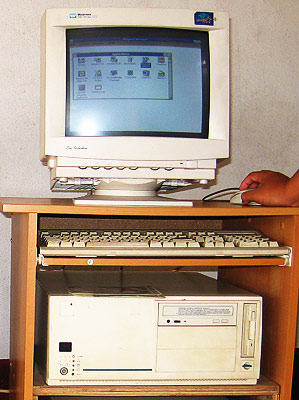 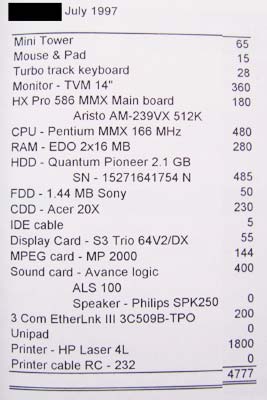 Imbi plaza was very close even though it was very difficult to go and to park the car. But seeing the availablity of the pieces, I have all the confidence to go myself. I had decided. Eventually, this was my first PC, brandless 586 series. Run by Windows 95. The printer was actually for the "quotation" purpose only. I did not pay for it. But there was one bought by Chitin Group which was hooked to my PC. Imbi plaza was very close even though it was very difficult to go and to park the car. But seeing the availablity of the pieces, I have all the confidence to go myself. I had decided. Eventually, this was my first PC, brandless 586 series. Run by Windows 95. The printer was actually for the "quotation" purpose only. I did not pay for it. But there was one bought by Chitin Group which was hooked to my PC.
With the first one running, and well connected, I had all the confident. Since then, I never pay any single cent to any supplier for one piece PC. I get all the components I needed directly from Imbi Plaza (later, since 2000 - Low Yat Plaza, nearby). I 'made' the computer for every body who wanted me to: my kiddos, my wife's sister, and sister's son, my own sister, even Dr Jumat. |
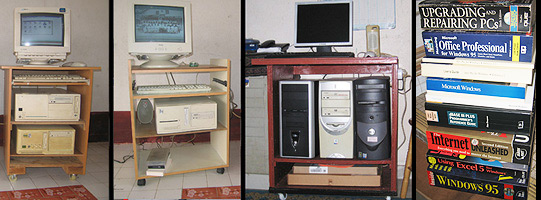 I spent not less than 50K of my own salary to literate and gear myself with ICT to this date. These are the collection that I kept alive for my own passion; housing the operating systems: DOS v7, Windows 3.11, Windows 95, Windows 98, Windows 2000, and Windows XP. (Note the customised computer tables I made myself). Those storage media, starting with 5.5" FD, and the highly consumable FDD itself. The CDD, and finally the DVD drive. The HDD that surely went broke when the time comes, normally while in high use. The many cards, including the display cards which went black from time to its expiry date. Even the monitors themselves. The RAM which required upgrading from time to time. The printers and the toners. The scanners. The UPS to prevent crash for my floor was infamous for its sudden blackout phenomenon. The books about ICT alone was not less than 1000. And currently, the blank CD and DVD, and the thumb-drives. And mice which died so fast. Was it a good investment? For passion point of view, yes. For career point of view, NO. Most of my colleagues did not spent this much from their own pocket. That amount was better spent on subsidising oneself for the conferences; the attendence and presentation of which bear some points towards promotion (a.k.a. pay increase). Tagged with the promotion is a fatter grant which can be used to acquire bigger and better ICT gears. It's a longer route, but more profitable, shorter time and more "cost-saving". At one time (386 time) my computer was the biggest in the department (hik, hik, hik) with an expanded 16 MB RAM (it cost me 700RM). I started using CDD when it was 450RM. Learning the "stupidity", I refrained myself from using a thumb-drive when it was 1 RM per MB. Currently, at ca. 60 RM per GB (6 cent per MB), I carry with me four thumb-drives as my briefcase. I spent not less than 50K of my own salary to literate and gear myself with ICT to this date. These are the collection that I kept alive for my own passion; housing the operating systems: DOS v7, Windows 3.11, Windows 95, Windows 98, Windows 2000, and Windows XP. (Note the customised computer tables I made myself). Those storage media, starting with 5.5" FD, and the highly consumable FDD itself. The CDD, and finally the DVD drive. The HDD that surely went broke when the time comes, normally while in high use. The many cards, including the display cards which went black from time to its expiry date. Even the monitors themselves. The RAM which required upgrading from time to time. The printers and the toners. The scanners. The UPS to prevent crash for my floor was infamous for its sudden blackout phenomenon. The books about ICT alone was not less than 1000. And currently, the blank CD and DVD, and the thumb-drives. And mice which died so fast. Was it a good investment? For passion point of view, yes. For career point of view, NO. Most of my colleagues did not spent this much from their own pocket. That amount was better spent on subsidising oneself for the conferences; the attendence and presentation of which bear some points towards promotion (a.k.a. pay increase). Tagged with the promotion is a fatter grant which can be used to acquire bigger and better ICT gears. It's a longer route, but more profitable, shorter time and more "cost-saving". At one time (386 time) my computer was the biggest in the department (hik, hik, hik) with an expanded 16 MB RAM (it cost me 700RM). I started using CDD when it was 450RM. Learning the "stupidity", I refrained myself from using a thumb-drive when it was 1 RM per MB. Currently, at ca. 60 RM per GB (6 cent per MB), I carry with me four thumb-drives as my briefcase.
|
Better DTP appeared for Windows. Wordstar and dBASE had long gone. Lotus was one. It offered a suit that one normally needed to prepare a paper work. I found that Amipro, the Lotus's word processor was superb. After 1994 first Chitin and Chitosan Symposium, I took to my office the papers and prepare its CRC, solely on Amipro 3.11, and finally published as the proceedings, by UKM Publisher (1995). And also later "Profil Activiti Pusat Penyelidikan Kitin Kitosan, UKM /Activity Profile of Chitin Chitosan Research Centre, UKM, (1995). Eventually Windows took over every aspects of modern hard copy production. And one was the UKM-ITB 5 2002 Proceedings which I lead its CRC production. The sweety Amipro became Wordpro which was in Word's regalia. That was the end.
 An award from DEWAN BAHASA dan PUSTAKA (Institute of Language and Literary) for getting deeply involved with them. Intensively for ca ten years from late 1980's to late 1990's. Books of original authorship, a large volume of translation, editing, as well as being in their production team of encyclopedia, and dictionaries. Admittedly, the advent of ICT had made this possible.
An award from DEWAN BAHASA dan PUSTAKA (Institute of Language and Literary) for getting deeply involved with them. Intensively for ca ten years from late 1980's to late 1990's. Books of original authorship, a large volume of translation, editing, as well as being in their production team of encyclopedia, and dictionaries. Admittedly, the advent of ICT had made this possible.
DBP is a Education Ministry organ for developing language. It is also a publisher of university books which private publishers dare not publish. This is the area where involvement of university staff is badly needed. My intimacy with DBP had a long history. It was since 1972 when I was still a student in UKM. Back then, I began by writing for "Dewan Masharakat". Then I approached the Book Division officials. My intensive participation was due to En Amran Joned in mid 1980's, a few years my junior in UKM. We were friends since then deep into the homes.
It was a lot of fun working together with DBP. To begin with, DBP always maintain its integrity of profesionalism: do it if you can, do not do it if you can not. And it put you in your place when it hire you for a certain "mission". I enjoyed very much going out on "mission" with DBP.
From an author point of view, DBP is the best and the most reliable publisher in town. It pays the royalty as agreed, and DBP never owe any author any single cent. Its only restriction is that its being a government body which has to follow certain rules, regulations, and guides that sometimes when subjected to it appeared like it is an inefficent institution. In the 1980's through to 1990's there were plenty of jobs for academia in DBP. And DBP was very vigorous in publishing the books in Bahasa Melayu. Until one day, someone had the opinion that DBP was wasting the public money whereas everybody alse saw it as the efforts of DBP to materialise the knowledge in Bahasa Melayu. Ironically, the commercial part of the institution was privatised.
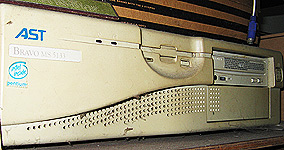 
|
The university eventually conceded to the fact that PC was the pen and paper of the time for the academia. It was not just a typewriter like they used them. There were committees at the university level, and similar replica at the faculty level, and at the department level. It was recognised that some IT materials could be distilled off for students as well as for the academia in the faculty. I benefitted in getting the first batch of consignment, some times in 1996. The AST series, Bravo MS 5133, powered by Pentium S running on Windows 95. This was the first genuine branded PC with genuine registered Windows we had ever taste. It was not very much better than the one I had personally performance-wise. So, a few days after I received it, I reformatted the HDD, and experimented on the installation from the backup - which was retrieved from the piece into 50 pcs of 3.5" 1.4mb diskettes. Ironically there was not even a CDD. I had furnished it myself. Since then I always had two PC in my office. And always one at home for the kiddos. In 1996, I went for an ICT course run by UKM Computer Centre on data/info acquisation through internet. And another one in 1998 for the MM presentation of the ICT.
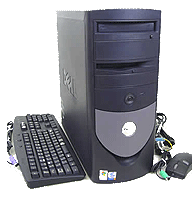 The university "replenished" my AST with this one, Dell Optiplex GX240 set in 2002 Mar, by virtue that I was the faculty ICT coordinator. It was an outdated set, that was widely advertised on TV at 1999 RM. It was a P4 still running on Windows 98. My IP-based pages were stored in this PC to its shut down because of my retirement. |
A sense of connected was prevailing in the university that could not be stopped. The talk of the time about being connected was the web pages. The faculty began one by Dr Harun himself, and he began a crude one for Chem Dept. In 1998, he asked me to continue it and developed. I was then the webmaster for the Chem Dept to my last day in UKM. It did not appear very much finger prints of the head in this case, because most of them were literally illiterate. I do not wish the new webmaster to inherit my composition, and I do not wish to go and being seen to brief the filing management of the site. It would be better for the new webmaster to start a new one so that he/she could master the filing system. The web nowadays were very complex. The last two front pages are here. Link within the folders are dead of course. My appointment was reconfirmed in 1999 July when Chem Dept was dissolved to make way for the School of Chemical Science and Food Technology. For a brief period in 2003, when the faculty's webmaster fall vacant, and no new candidate appeared on the horizon, I was made to take care of it (then I was the ICT coordinator for the faculty of science and technology). At least to update the vital information. The early page is here. It is only the front page. Link within the folders are dead of course.
During this period of time also I created my pages in my own PC, knowing that, being connected, every one can read it. And I was greatly hoping that those I wanted to know read and see them. It was IP based 202.185.55.23. I did not perceive the university would allow such a personal homepage to reside in the university server. The search engine were then available, and it searched almost all I wanted. And suddenly, I was every where and every time in the space. Spanning from the geolocation where I was to be born, to my last day in UKM, and to this day. People out there are actually reading my pages. They contacted me for various reasons. In abaout year 2000, it was a surprise encouragement by the university to fill its server with the webpages, personal or official. I guessed, the university had opened its eyes to see what was going on about the webpage out there about the academia world. And I grabbed the first opportunity to register it; www.ukm.my/mbz which was practically pkukmweb.ukm.my/~mbz/index.html, and to this date are there with the last update on 2007 Apr 10, the last day I was in UKM. At about this time the virus of Windows was phenomenal. The university had to block the IP-based server of the academia personal PC, except for intranet access. So my pages in my PC in my office was only for my students to access the lecture notes, and things like that. And as a backup copy of the whole folder. The Google cached a huge amount of my files from the IP-based server. In 2007, to my surprise, a click on 202.185.55.23 opened back the nostalgic pages. I simply wonder why UKM was that soft. I am also wandering how long the university will let my pages stay in the server. It was a staggering 700 mb. When the university opened up for the academia pages, it said the space was 15mb each. Since only a few academia took up the offer, the balance space was big enough that perhaps the university did not notice my folder took up 700 mb. Its ok if the university want to delete it. The copy of it, and their updates had been "rescued" and safely resided in the current site. I would very much appreciate if the university could let the folder exist, and the front page alive; just like what other universities in the developed countries do to their former sudents and staff.
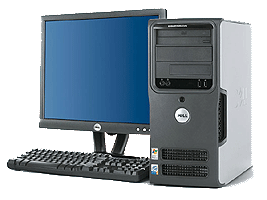 The faculty "replenished" my Dell GX240 with this one, a Dell Dimension set in 2006 May, by virtue that I was the school webmaster. This was after I barked very loud and very clear in several faculty webmasters meetings. Some body obviously got annoyed with me for that. But I had to, because the others were all very young. The new PC came with the letter of reappointment from the dean, Prof Jalil, (the first of such letter since 1998), of the webmaster three years more, i.e. to 2009. With such a letter, I could not gauge his concern about my retirement in 2007. It run on Windows XP. My own PC run on Windows 2000, and the Dell 240 on Windows 98. I opened the box only 2007 Apr 19, the last day I was in the office. Nonetheless, I used the LCD screen for healthier vision. Whoever inherit it will be lucky, because it was still blank when I left. |

Towards the end of my career-life, I was cornered into the dead-end so-called STPD. I was on STPD long time ago since late eighties, but it was on History and Phylosophy of Science. It was fine, because the group to handle was only about twenty. However from 2000 Jun to 2005 Dec was about ICT, the subject the faculty had adopted to become the faculty's compulsory subject in the category of technical skill. This was also the period I was appointed the ICT Coordinator by the Vice Chancellor for FST, replacing Dr Harun who was appointed the Deputy Director of the Computer Centre. In fact the job of the former was by virtue of the latter.
I served three deans: Prof Ikram, Prof Latif, and Prof Jalil. Personally, I felt very much at pleasure during the second dean. It was during him that the ICT coordinator (and the webmaster) were included as members of the faculty managers which crucially decide on everything very important things monthly. He gave me the opportunity to attend to the highest level meetings. And I learned a lot during the meetings. During the period of the three deans I conducted four ICT course for the faculty staff. All on the insistence of the dean. The only thing that I could 'avert' was to put the organisation of it under the committee other person, the professor, chaired. That was a relief in organising. I did not mind conducting the course. During my coordinating time, ICT laboratories "rented" by the FTSM in the Chem Building were returned, with the content in them - the obsolete AST that eventually became a headache to myself and a colleague Dr Kadderi. I made the decision to use these labs for the STPD1113, while those in the Physics Building for the second year STPD2112. Some space used by the Computer Centre in the Math Building was finally vacated. I redesigned the space to become two conjoined ICT Lab to house 60 PCs. A new deanery complex was rumoured to be built uphill. In one of the labs, a space was reserved for PC. I designed the Lab to housed 15 PCs and would be of type wireless.

Not so in the school though. Only in 2007, the school admitted the webmaster as one of the school managers. But I had only two chances of meeting. 2007, Feb and Mar. I was given a committees members myself, and a science officer who more or less a sec. I managed to conduct one course for the school staff on e-learning, in 2006 Dec. For the first time in UKM I signed the certificates of those de facto more senior than me. At least they get noticed that I had a legend in the Chemistry UKM. Many more activities were on the list. The school chairman asked me to do the jobs more than he asked his own secretary. Then I retired.
The other task for being the coordinator was huge. Inseminating the fundamental of ICT to practically all the faculty first year student. It totalled close to a thousand per session; divided into two semester. These were the largest classes I was made to handle. The irony was, the period spanned from the era of the most primitive teaching gear: the OHP, to the most modern: the Laptop+LCD. And were conducted in the hall (DAM) which is not meant for teaching/lecture puposes. Plus the hand-on practical. Again ironically from the lowest compuer set: AST's pentium S to that of pentium 4 (Dell and HP).
 |
The paper was called STPD1113 - Fundamental of Microcomputer and Information Technology. Teaching it was very fun. I always looked forward for the lecture. Students as many as 600 registered for the course because it was a compulsory paper. It was always in the DAM, which was not meant for the lecture. In the begining the teaching aid was the OHP. Only lately it was by laptop+LCD. And the lecture was always in the evening, the time everyone was free even though the paper was the faculty paper. I loved teaching this paper, more than I did for the physical chemistry. Those who attended the lecture were very keen indeed. When came to the hardware update, I would visit the Imbi Plaza (later Low Yat Plaza) and made some scan on the new hardware upgrades.
But I was in agony when came the practical part. Apparently my colleague, Dr Kadderi had more ideas about it. Initially the deanery did not give a serious thought on the implementation of the course. They took it like it was like other STPD courses which were handled by groups of lecturers in groups. Unfortunately not many wanted to get involve. So I demanded tutors be provided adequately. I pushed it through the ICT committees as well as the STPD committee. I asked the minutes be written, and later I quote the minutes. I made it though, but I sensed involuntarily because that involved a quite sum of fund which the admin would like very much to use it for the benefits not like paying the tutors. The last lecture was in Sem I 2005/2006. Dr Kadderi and I managed to 'extricate' ourselves out of the STPD web from Sem II 2005/2006. It was a great relief. The admin felt a sort of 'rebelion' because to find the replacement for that kind of zero-point service was a non-voluntary. But they always did it. Giving it to young lecturers. The costly passion of ICT acquired a unique rare knowledge and skills. Maintaing the faces of chemistry using the ICT consumed a lot of time, and the changes were very dynamic. ICT searched everywhere. But at the end of the day it did not answer the vital question: WHERE ARE THE PAPERS?
The eventuality of the notebook, or the laptop, was inevitable. They made their appearence in early 1990's, but beyond my reach, through grant. Not to mention privately. It posted something like 15K. Many of my luckier colleagues had enjoyed it since many years ago from various source of funds. But I had to wait. It took me fifteen years of waiting.

It was in 2005 May, a Compaq Presario 1700T, made in 2001 in the USA. It was donated by my #3son, Zidni after he acquired a 'titanic' Mac's Powerbook. It was not perfect and run by Windows 2000 on a pentium III with only 20 gb HDD and about 700 MHz speed. But I took it to the university and used it for sometimes for the lecture (until university installed a stable desktop in the lecture theatres). It had a bandage at the screen which sometimes goes blank that I had to have a CRT for standby. It was reformatted a few times, had the HDD changed once, and sometimes played the movie upside down. And made emergency stop at every change of breath. But at least, like every body else, I had a notebook that made I was a lecturer of the day.

Admittedly, it is now the era of notebook. After the university paid my golden-handshake, I joined them with an HP Compaq Presario V3203TU. My passion is keeping me ticking. It stops at only of assembling my own from pieces like I did for my desktops; at least today is.
